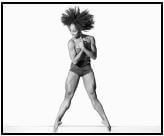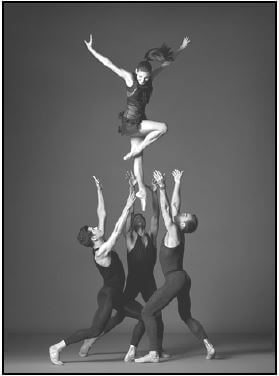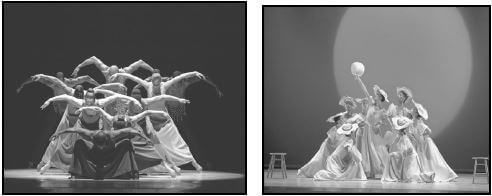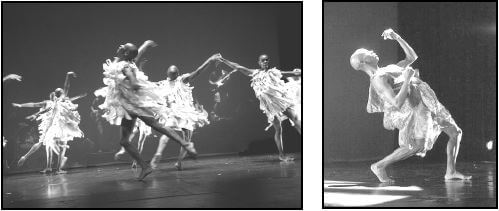DANCE STUDIES GRADE 12 QUESTIONS - NSC EXAMS PAST PAPERS AND MEMOS NOVEMBER 2018
Share via Whatsapp Join our WhatsApp Group Join our Telegram GroupDANCE STUDIES
GRADE 12
NSC EXAMS
PAST PAPERS AND MEMOS NOVEMBER 2018
INSTRUCTIONS AND INFORMATION
- This question paper consists of TWO sections with 11 questions in total. Answer only SEVEN questions as follows:
SECTION A: SAFE DANCE PRACTICE AND HEALTH CARE (40 marks)
* Answer THREE of the four questions in this section.
* You have a choice between QUESTION 4 and QUESTION 5. If you answer both questions, only the FIRST answer will be marked.
SECTION B: DANCE HISTORY AND LITERACY (60 marks)
* Answer FOUR of the six questions in this section.
* You have a choice between QUESTION 8, QUESTION 9 and QUESTION 10. If you answer all three questions, only the FIRST answer will be marked. - Number the answers correctly according to the numbering system used in this question paper.
- Read each question carefully and take note of what is required.
- One-word answers will NOT be accepted if you are requested to explain/ elaborate/describe/analyse/evaluate/compare, etc. Write your answers in full sentences.
- You may do rough planning in the ANSWER BOOK. Draw a line through any work that should NOT be marked.
- You will be assessed on your ability to:
- Write in only one language
- Organise and communicate information clearly
- Use the specific format required in certain questions
- Use specialist dance terminology where appropriate
- Write neatly and legibly.
QUESTIONS
SECTION A: SAFE DANCE PRACTICE AND HEALTH CARE
QUESTION 1: COMPONENTS OF FITNESS (COMPULSORY)
1.1 Give a definition for EACH of the FIVE components of fitness below.
- Core stability
- Flexibility
- Strength
- Endurance/Stamina
- Neuromuscular skills (5)
1.2 Analyse how inadequate core stability could affect a dancer's performance. (5)
1.3 In your opinion, how could you develop high levels of fitness in your dance classes? Give detailed examples to substantiate your answer. (5) [15]
QUESTION 2: CAUSES OF INJURIES (COMPULSORY)
Explain how poor dance technique can lead to injuries in the dance class. Give examples to substantiate your answer. [7]
QUESTION 3: NUTRITION AND HYDRATION (COMPULSORY)
3.1 Explain how good nutrition can enhance a dancer's technical ability and dance performance. Give examples to substantiate your answer. (4)
3.2 Explain why dancers have to stay hydrated during classes and performances (4) . [8]
NOTE:
- You have a choice between QUESTION 4 and QUESTION 5.
- Answer only ONE of these questions.
QUESTION 4: MUSCLES AND ANATOMICAL ACTIONS (CHOICE QUESTION)
NOTE: Answer this choice question only if you have studied muscles and anatomical actions in class.
4.1 Choose an action from COLUMN B that matches a muscle in COLUMN A. Write only the letter (A–D) next to the question numbers (4.1.1 to 4.1.4) in the ANSWER BOOK. (4 x 1) (4)
COLUMN A | COLUMN B |
4.1.1 Gracilis |
|
4.2 Refer to the image below and answer the following questions related to the anatomical actions occurring in this movement. 
[Source: www.pinterest.com]
4.2.1 Which muscle is responsible for the anatomical action occurring in the elbow joints? (1)
4.2.2 Which muscle is responsible for the anatomical action occurring in the head? (1)
4.2.3 Name ONE action occurring in the hip joint and ONE muscle responsible for the action. (2)
4.2.4 Name ONE muscle responsible for the anatomical action occurring in the knee joint. (1)
4.2.5 Name ONE muscle responsible for the anatomical action occurring in the ankle joint. (1) [10]
OR
QUESTION 5: SAFE DANCE PRACTICE AND MOVEMENT QUALITY (CHOICE QUESTION)
5.1 Indicate whether the following statements are TRUE or FALSE. Write only 'true' or 'false' next to the question numbers (5.1.1 to 5.1.4) in the ANSWER BOOK.
5.1.1 A good cool down prevents blood from pooling in the limbs. (1)
5.1.2 A dynamic warm-up involves continuous movement. (1)
5.1.3 During a cool down lactic acid is removed from muscles to prevent cramps. (1)
5.1.4 During a cool down the heart rate increases. (1)
5.2 Knowledge of movement qualities contributes to a high level of performance. Explain the following movement qualities:
5.2.1 Musicality (1)
5.2.2 Transitions (1)
5.2.3 Dynamics (1)
5.2.4 Projection (1)
5.2.5 Fluency (1)
5.2.6 Commitment (1) [10]
TOTAL SECTION A: 40
SECTION B: DANCE HISTORY AND LITERACY
QUESTION 6: TECHNIQUE OF DANCE MAJOR (COMPULSORY)
6.1 Name your dance major.
6.2 Name FIVE techniques used in your dance major. (5)
6.3 Outline EACH of the techniques named in QUESTION 6.2. (5) [10]
QUESTION 7: DANCE ELEMENTS AND CHOREOGRAPHY (COMPULSORY)
7.1
7.1.1 Analyse how the dance elements SPACE and FORCE are used in the image below. (4)
7.1.2 Evaluate how the dance element TIME is used in the image below. (2)  [Source: http://www.danceconsortium.com]
[Source: http://www.danceconsortium.com]
7.2 How did the choreography practical assessment task (PAT 1) develop you as a person and as a dancer? (4) [10]
NOTE:
- You have a choice between QUESTION 8, QUESTION 9 and QUESTION 10.
- Answer only ONE of these questions.
QUESTION 8: ALVIN AILEY AND REVELATIONS (CHOICE QUESTION)
Imagine you are Alvin Ailey and you are being interviewed. Answer the following questions. Marks will be awarded for the correct format for an interview.
Correct format for an interview. (2)
8.1 Describe your childhood. (2)
8.2 Explain how your upbringing helped to inspire some of your dance works. (3)
8.3 Outline your contribution to dance and society. (3)
8.4 Describe how you used production elements in the themes of 'Pilgrims of Sorrow' and 'Move Members Move', as shown in the images below.  [Photographs by Gert Krautbauer] (6)
[Photographs by Gert Krautbauer] (6)
8.5 Explain how the music enhanced Revelations. (5)
8.6 Explain how you showed deep emotions in your movement vocabulary in 'Pilgrims of Sorrow' and 'Move Members Move'. (6)
8.7 In your opinion, what makes Revelations such a timeless piece? (3) [30]
OR
QUESTION 9: GREGORY MAQOMA AND FOUR SEASONS (CHOICE QUESTION)
Imagine you are Gregory Maqoma and you are being interviewed. Answer the following questions. Marks will be awarded for the correct format for an interview.
Correct format for an interview. (2)
9.1 Describe how your interest in dance started. (2)
9.2 Describe your professional career as a dancer/choreographer. (3)
9.3 Outline your contribution to dance and society. (3)
9.4 Describe how you used production elements to show the different themes in 'Spring' and 'Autumn', as shown in the images below.  [Photographs by John Hogg] (6)
[Photographs by John Hogg] (6)
9.5 Explain how the music enhanced Four Seasons. (5)
9.6 Explain the movement vocabulary you used in this dance work. (6)
9.7 In your opinion, what makes Four Seasons such a relevant dance work in today's society? (3) [30]
OR
QUESTION 10: CHOREOGRAPHER AND DANCE WORK (CHOICE QUESTION)
Choose ONE of the choreographers and ONE of his/her dance works from the prescribed list below. Marks will be awarded for the correct format for an interview.
INTERNATIONAL CHOREOGRAPHERS | DANCE WORKS |
Christopher Bruce | Ghost Dances |
George Balanchine | Apollo/Jewels (Emeralds, Rubies, Diamonds) |
Jiři Kylián | Wings of Wax/Stamping Ground |
Martha Graham | Lamentation/Errand into the Maze |
Matthew Bourne | Swan Lake/Cinderella |
Mats Ek | Giselle/Swan Lake/Carmen |
Pina Bausch | The Rite of Spring |
Rudi van Dantzig | Four Last Songs |
William Forsythe | In the Middle, Somewhat Elevated |
| SOUTH AFRICAN CHOREOGRAPHERS | DANCE WORKS |
Alfred Hinkel | Cargo/I am Cinnamon/Rain in a Dead Man's Footprints/Last Dance (Bolero) |
Carolyn Holden | Blood Wedding/Imagenes |
Dada Masilo | Swan Lake/Romeo and Juliet |
Gary Gordon | Bessie's Head |
Mavis Becker | Flamenco de Africa |
Sylvia Glasser | Tranceformations |
Gregory Maqoma | BeautyTriology/Skeleton Dry |
Veronica Paeper | Orpheus in the Underworld/Carmen |
Vincent Mantsoe | Gula Matari |
Give the name of the choreographer and the title of the dance work that you have chosen.
Answer the questions as if you are the choreographer being interviewed. Correct format for an interview. (2)
10.1 Describe your dance training and your professional career as a dancer/ choreographer. (5)
10.2 Outline your contribution to dance and society. (3)
10.3 Describe how the use of production elements enhanced the intent/theme of this dance work. (6)
10.4 Explain how the music enhanced the dance work. (5)
10.5 Explain how symbolism was used in the movement vocabulary of this dance work. (6)
10.6 Why would you recommend that people watch this dance work? (3) [30]
QUESTION 11: DANCE WORK (COMPULSORY)
NOTE: Do NOT answer on the same choreographer and dance work that you have chosen for QUESTION 8, QUESTION 9 or QUESTION 10.
Choose ONE of the dance works from the prescribed list below.
INTERNATIONAL CHOREOGRAPHERS | DANCE WORKS |
Christopher Bruce | Ghost Dances |
Alvin Ailey | Revelations |
George Balanchine | Apollo/Jewels (Emeralds, Rubies, Diamonds) |
Jiři Kylián | Wings of Wax/Stamping Ground |
Martha Graham | Lamentation/Errand into the Maze |
Matthew Bourne | Swan Lake/Cinderella |
Mats Ek | Giselle/Swan Lake/Carmen |
Pina Bausch | The Rite of Spring |
Rudi van Dantzig | Four Last Songs |
William Forsythe | In the Middle, Somewhat Elevated |
SOUTH AFRICAN CHOREOGRAPHERS | DANCE WORKS |
Alfred Hinkel | Cargo/I am Cinnamon/Rain in a Dead Man's Footprints//Last Dance (Bolero) |
Carolyn Holden | Blood Wedding/Imagenes |
Dada Masilo | Swan Lake/Romeo and Juliet |
Gary Gordon | Bessie's Head |
Mavis Becker | Flamenco de Africa |
Gregory Maqoma | Four Seasons/BeautyTrilogy/Skeleton Dry |
Sylvia Glasser | Tranceformations |
Veronica Paeper | Orpheus in the Underworld/Carmen |
Vincent Mantsoe | Gula Matari |
Give the name of the choreographer and the title of the dance work that you have chosen.
Evaluate how the intent/theme of the chosen dance work is symbolically portrayed in the use of production elements and movements. Substantiate your response with examples from the dance work. [10]
TOTAL SECTION B: 60
GRAND TOTAL: 100